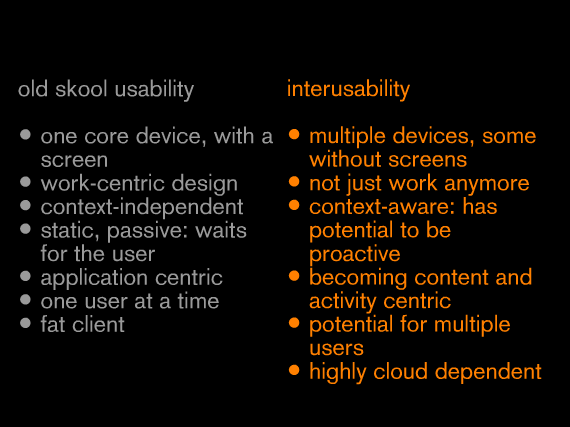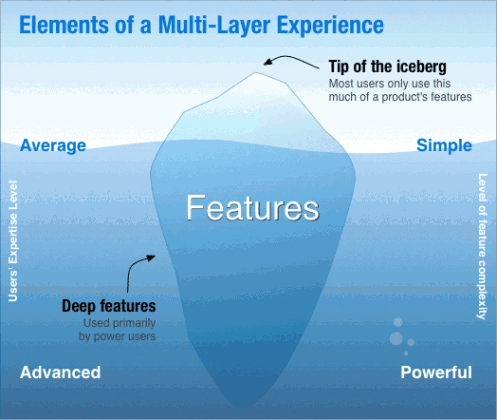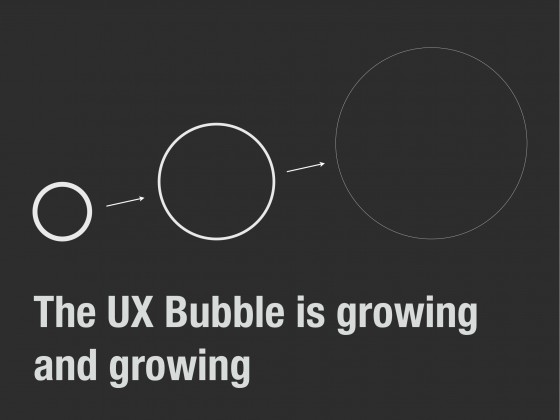
Źródło: prezentacja Service design for the cloud of diverse devices w ramach Open Desktop Summit 2011, Claire Rowland
In user experience we trust

Źródło: prezentacja Service design for the cloud of diverse devices w ramach Open Desktop Summit 2011, Claire Rowland

Źródło: Designing Enjoyable User Interfaces: Lessons learned from computer games, Thomas W. Malone, Konigi

Żródło: Truth and Dare - Out of the echochamber into the fire (ekran 107)
Źródło: Truth and Dare – Out of the echochamber into the fire, Jason Mesut, Head of User Experience at RMA Consulting
We embarked on a little experiment. We asked a ton of people to send us their settings file for Microsoft Word. At the time, MS Word stored all the settings in a file named something like config.ini, so we asked people to locate that file on their hard disk and email it to us. Several hundred folks did just that.
We then wrote a program to analyze the files, counting up how many people had changed the 150+ settings in the applications and which settings they had changed.
What we found was really interesting. Less than 5% of the users we surveyed had changed any settings at all. More than 95% had kept the settings in the exact configuration that the program installed in.
Źródło: Do users change their settings?, Jared Spool, UIE Brain Sparks.
Bardzo dobra prezentacja z tegorocznych warsztatów UXLX, autorstwa Luisa Rosenfelda, współautora klasycznej książki poświęconej architekturze informacji. Absolutny must read.
Źródło: Slideshare, Louis Rosenfeld

Źródło: Onward Search 2011
Ran Kivetz, Oleg Urminsky i Yuhuang Zheng opisali w 2006 roku badanie, którego celem było zbadanie skuteczności “iluzji postępu” (illusion of progress). W ramach eksperymentu, 108 klientom kawiarni wręczono karty lojalnościowe, które umożliwiały otrzymanie darmowej kawy/wypieku po zebraniu 10 pieczątek. Badani otrzymali dwa typy kart: z 10 polami do wypełnienia oraz z 12 polami, gdzie dwa pierwsze pola zostały już wypełnione. Klienci, którzy otrzymali kupony z 10 polami, zbierali średnio pieczątki po 16 dniach, a ci którzy dostali 12 polowe kupony – średnio po 13 dniach, czyli zdecydowanie szybciej.
Method. The participants were 108 customers of the café we described previously. They were randomly assigned to either a control condition or an experimental (illusionary goal progress) condition. Specifically, research assistants posing as café employees randomly offered customers either a 10-stamp or a 12-stamp coffee card (…). The 10-stamp and the 12-stamp cards indicated that members were required to accumulate 10 and 12 coffee purchases, respectively, to earn one free coffee. However, customers assigned to the 12-stamp experimental condition received two preexisting bonus stamps, described as an offer to anyone who opted to join the program. Thus, although the two groups faced identical effort requirements when joining the program (i.e., r – nt = accumulating 10 coffee purchases), the experimental group started with a lower proportion of original distance remaining to the goal than did the control group (i.e., dt+2 = .83 and dt = 1.0, respectively). All other aspects of the program were held constant across the two conditions and were identical to those we described previously for the café RP.
Results. Consistent with H2, the results indicate that illusionary goal progress led to faster completion of the reward requirement. On average, customers in the control condition completed the ten required purchases (for the 10-stamp card) in 15.6 days. In contrast, customers in the experimental (illusionary goal progress) condition completed the ten required purchases (for the corresponding 12-stamp card) in only 12.7 days, nearly three days or 20% faster (t = 2.0, p < .05; medians = 15 versus 10 days; Z = 2.1, p < .05 [Mann–Whitney U test]).
Źródło: The Goal-Gradient Hypothesis Resurrected: Purchase Acceleration, Illusionary Goal Progress, and Customer Retention, Ran Kivetz, Oleg Urminsky, Yuhuang Zheng Journal of Marketing Research, Vol. XLIII (February 2006), 39–58, American Marketing Association
Brytyjska agencja Econsultancy, w przeprowadzonej na przełomie czerwca i lipca 2011 roku ankiecie zapytała 364 agencje interaktywne (digital agencies) o ich stawki za 8 godzinny dzień pracy. Czy to na skutek kryzysu, czy też większego zainteresowania użytecznością, projektowaniem interakcji i dostępnością – średnie stawki na tych stanowiskach są niższe niż trzy lata temu w tym samym badaniu.
W przypadku projektów wartych powyżej 5 milionów funtów, stawki są znacząco wyższe i rozpoczynają się od 750 funtów.
Źródło: Digital Agency Rate Card Survey 2011, Econsultancy, London, United Kingdom 2011
W sierpniowym numerze Core77, Don Norman, autor m.in. kultowego Design of Everyday Things, współzałożyciel Norman Nielsen Group opublikował esej, który ma szansę stać się w przyszłości (niestety) jednym z najbardziej popularnych uzsadanień/wymówek do niewykonywania badań przed etapem projektowania:
Here are five very different arguments to support the practical reality of starting by designing, not through design research. First, the existence of good design that was not preceded by research. Second, the argument that experienced designers already have acquired the knowledge that would come from research. Third, the research effort of a company ought to be continually ongoing, so that results are available instantly. Fourth, and most controversial, research might inhibit creativity. And fifth, when the product is launched and the team assembled, it is already too late.
(…)
When I was a professor of cognitive science, I learned that reading and becoming expert at the existing research literature created a delicate tradeoff. Too much knowledge could be harmful. The point of my students’ PhD dissertations (and of all my own research) is to make a significant advance in the understanding of a topic. Read too much of the existing literature about what previous researchers have thought and done and you will follow in their footsteps. This means that you will also encounter the same dead ends. Without knowing the literature, you can be creative and often discover valuable new insights and directions.
Źródło: Act First, Do the Research Later, Don Norman, Core77
This review identifies that two areas in which we might expect to find research on service design – within design literature and within services literature – have not produced a developed body of knowledge. Rather, what emerges are two important tensions. The first is between understanding design either as problem-solving that aims to realize what has already been conceived of, or as an exploratory enquiry involving constructing understanding about what is being designed, involving end users and others in creating meaning. The second is a tension between the view that the distinction between goods and services matters significantly, or that service is better understood as a fundamental activity with multiple actors within a value constellation. Figure 1 summarizes these perspectives.
The framework in Figure 1 has two axes: one concerns how service is understood, the other concerns the nature of design. Together, the quadrants propose distinct ways of understanding service design. In the top left quadrant, design is seen as problem-solving and the conventional distinction between goods and services is maintained, a view that underpins work in some management fields (…) This quadrant is labeled “engineering” as its focus is the design of new products and services that can be specified in advance using systematic procedures; services are one particular category of artefact to be designed. Below, design can be understood as an exploratory process of enquiry that can be applied to different kinds of artefact such as products or services and where the distinctions based in industrial manufacturing between types of designed things matter (…). Within this quadrant sit the conventional fields or sub-disciplines of design in the art or design school traditions, with their focus on particular kinds of artefact such as furniture design, interiors or interaction design. This quadrant is labeled “non-engineering design disciplines”.
The top right quadrant sees design as problem-solving, but views service as a fundamental process of exchange (…) influenced by the service-dominant logic (…). This quadrant is labeled “service engineering” since the emphasis is on service, but the underlying design tradition is engineering. Finally, the bottom right quadrant sees design as an exploratory enquiry, but does not make an important distinction between goods and services (e.g, Bate & Robert, 2007). This quadrant is labeled “designing for service” rather than designing services, echoing work by several practitioners and scholars in the use of the preposition “for” (cf Meroni & Sangiorgi, 2011; Kimbell & Seidel, 2008). As Manzini (2011) similarly argues, talking of designing for services rather than designing services recognizes that what is being designed is not an end result, but rather a platform for action with which diverse actors will engage over time. Designing for service, rather than designing services, points to the impossibility of being able to fully imagine, plan or define any complete design for a service since new kinds of value relation are instantiated by actors engaging within a service context. Designing for service remains always incomplete (cf Garud et al, 2008).
This framework makes explicit differences in how people think about design and service, shaping how service design can be understood. It helps illuminate the underlying concepts about design and service that practitioners bring to their work as they engage in service design.
Źródło: Kimbell, L. 2011 Aug 14. Designing for Service as One Way of Designing Services. International Journal of Design [Online] 5:2. Available: http://www.ijdesign.org/ojs/index.php/IJDesign/article/view/938/345
Copyright © 2010 - 2024 Tomasz Skórski · Autor na Google+
Recent Comments